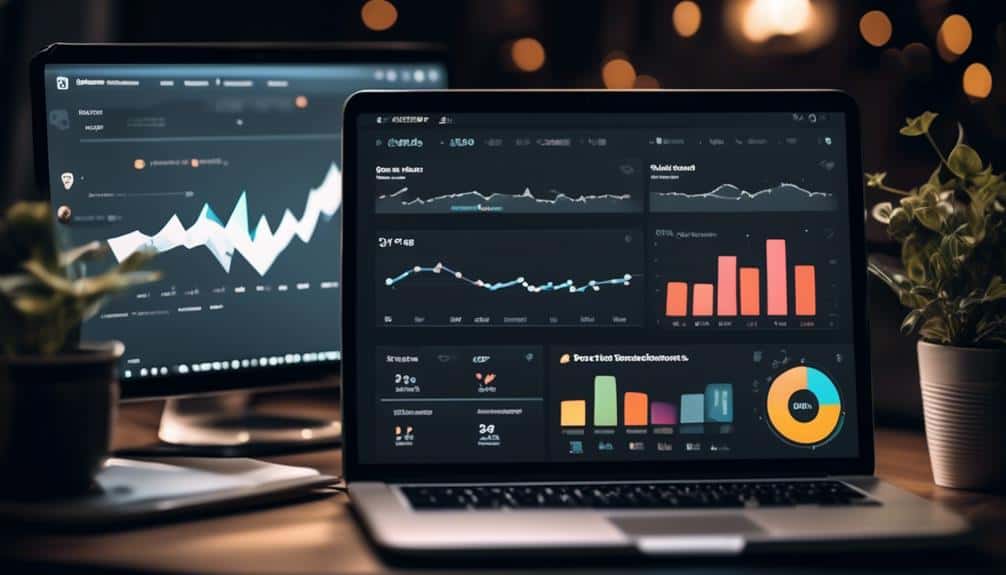Navigating Social Media Dashboards: A Comprehensive Guide to Analytics Tools
When it comes to social media marketing, did you know that 73% of marketers believe that their efforts through analytics tools are somewhat effective in achieving their goals?
Understanding the intricacies of social media dashboards and analytics tools is crucial in maximizing your online presence.
As you delve into the world of social media analytics, you will uncover a wealth of insights that can transform how you engage with your audience and refine your digital strategy.
Key Takeaways
- Customization of social media dashboards is crucial for accurate tracking and tailored data display
- Real-time monitoring and tracking capabilities provide valuable insights for prompt adjustments in digital marketing strategies
- Analyzing engagement metrics like likes, comments, and shares is essential for optimizing content strategy and assessing audience responsiveness
- Utilizing specialized tools and features for data visualization simplifies complex data interpretation and aids in making strategic decisions
Importance of Social Media Analytics

Understanding the significance of social media analytics is pivotal for businesses seeking to optimize their digital marketing strategies. Data interpretation plays a crucial role in unlocking valuable insights from the vast amount of information generated on social media platforms. By analyzing metrics such as engagement rates, click-through rates, and audience demographics, businesses can tailor their content to resonate with their target audience effectively. Performance evaluation through social media analytics enables companies to track the success of their campaigns in real-time, allowing for quick adjustments to maximize impact.
Effective data interpretation is essential for making informed decisions based on the trends and patterns identified through social media analytics. By leveraging these insights, businesses can refine their marketing strategies, improve customer engagement, and drive conversions. Performance evaluation metrics provide concrete evidence of the effectiveness of digital marketing efforts, enabling businesses to allocate resources efficiently and achieve their objectives. Embracing social media analytics empowers businesses to stay agile, adapt to changing market conditions, and maintain a competitive edge in the digital landscape.
Understanding Metrics and KPIs
To effectively gauge the performance of your social media efforts, it's imperative to delve into the realm of metrics and Key Performance Indicators (KPIs). Understanding trends and measuring success through these metrics is crucial for optimizing your social media strategy.
Here are three key points to consider:
- Engagement Metrics: Monitor likes, comments, shares, and overall interactions to gauge how well your audience is engaging with your content. High engagement rates indicate that your content resonates with your audience, while low engagement may require a content strategy adjustment.
- Reach and Impressions: Analyze the reach and impressions of your posts to understand how many users are exposed to your content. This data helps in evaluating the effectiveness of your content distribution strategy and can guide decisions on boosting posts for wider reach.
- Conversion Rates: Track conversion metrics such as click-through rates, lead generation, and sales attributed to social media efforts. Understanding how social media contributes to conversions is essential for measuring the overall impact on your business goals.
Popular Social Media Dashboard Tools

When evaluating popular social media dashboard tools, focus on their top dashboard features, pricing and plans, and user interface comparison to make an informed decision.
These aspects are crucial in determining which tool aligns best with your social media analytics needs and business goals.
Top Dashboard Features
Exploring the dashboard features of popular social media tools reveals key functionalities crucial for effective social media analytics.
- Customization options: Tailoring your dashboard layout to display metrics that matter most to your social media strategy enhances your ability to track performance accurately.
- Data visualization: Interactive charts, graphs, and reports help translate complex data into easy-to-understand visuals, enabling you to identify trends and make informed decisions swiftly.
- Performance tracking: Real-time monitoring of key performance indicators (KPIs) allows you to measure the impact of your social media efforts promptly and adjust strategies for optimal results.
Pricing and Plans
Analyzing the pricing and plans of popular social media dashboard tools reveals essential insights for strategic decision-making in selecting the most cost-effective solution for your analytics needs.
When evaluating these tools, consider customization options that allow tailoring the platform to your specific requirements. Many providers offer tiered subscription benefits, enabling you to choose a plan that aligns with your budget and usage demands.
Assess the value for money each tool offers, balancing the cost against the features provided. Premium features like advanced analytics, competitor analysis, and real-time monitoring may justify a higher price point if they meet your strategic objectives.
User Interface Comparison
Comparing the user interfaces of popular social media dashboard tools offers valuable insights into their usability and design efficiency. When evaluating user experience and design comparison, consider the following:
- Customization Options: Look for platforms that allow you to tailor the dashboard layout to suit your preferences, ensuring a personalized user experience.
- Intuitive Navigation: Opt for tools with a user-friendly interface and intuitive navigation menus to enhance usability and streamline your social media management process.
- Visual Data Representation: Choose a dashboard tool that presents analytics and metrics in visually appealing ways, such as graphs or charts, to make data interpretation easier and more efficient.
Setting Up Your Analytics Dashboard

To efficiently track and monitor your social media performance, begin by configuring your analytics dashboard with key metrics and performance indicators. Dashboard customization plays a crucial role in tailoring the display of data to suit your specific needs. Utilize features that allow for easy data visualization, such as customizable graphs, charts, and widgets. By organizing your dashboard to highlight the most relevant metrics for your goals, you can streamline your data interpretation process.
Performance tracking is at the core of effective social media analytics. When setting up your dashboard, prioritize metrics like engagement rates, reach, click-through rates, and conversion numbers. These indicators provide valuable insights into the effectiveness of your social media strategies. Make use of real-time tracking capabilities to stay informed about your performance as it happens.
Data interpretation is key to making informed decisions based on your social media analytics. Arrange your dashboard in a way that facilitates quick analysis and comparison of different metrics. By setting up a well-structured analytics dashboard, you can optimize your social media performance and drive strategic growth.
Analyzing Engagement and Reach
Begin dissecting the intricate web of engagement and reach metrics to uncover valuable insights into your social media performance. By delving into engagement trends and conducting reach analysis, you can gain a deeper understanding of how your audience interacts with your content and the extent of your content's reach.
Key Insights for Analyzing Engagement and Reach:
- Engagement Trends: Track how your audience engages with your posts over time to identify patterns and optimize your content strategy accordingly. Understanding when your audience is most active and responsive can help you tailor your posting schedule for maximum impact.
- Interaction Patterns: Analyze the specific ways in which your audience interacts with your content, such as likes, comments, and shares. Identifying these interaction patterns can help you fine-tune your messaging and create more engaging posts.
- Content Performance: Evaluate the performance of your content by assessing which posts generate the highest levels of engagement and reach. Use this data to refine your content creation strategy and focus on producing content that resonates with your audience.
Tracking Conversion Rates

When examining conversion rates, you'll focus on analyzing the effectiveness of your social media efforts in turning leads into customers.
Metrics like click-through rates and conversion rates are pivotal for tracking the success of your campaigns.
Utilizing specialized tools can provide precise measurements and insights into the performance of your social media marketing strategies.
Conversion Rate Analysis
Utilize conversion rate analysis as a powerful tool to track and optimize your conversion rates effectively. When delving into this aspect of analytics, consider the following:
- Implement Conversion Optimization Strategies: Experiment with A/B testing to identify high-performing variations and enhance conversion rates.
- Conduct Customer Journey Analysis: Dive into the customer journey to understand touchpoints and optimize them for better conversions.
- Utilize Funnel Visualization: Visualize the conversion funnel to pinpoint drop-off points and streamline the process for improved conversion rates.
Metrics for Tracking
To effectively track conversion rates, focus on key metrics that provide actionable insights into the performance of your conversion optimization efforts. Start by analyzing engagement rates to gauge how well your audience is interacting with your content.
Dive into audience demographics to understand who's converting and tailor your strategies accordingly. Monitor content performance closely to identify what resonates with your audience and drives conversions.
Consider forming influencer partnerships to expand your reach and attract new potential customers. By combining these metrics, you can create a holistic view of your conversion funnel and make data-driven decisions to optimize your social media marketing efforts effectively.
Stay proactive in tracking these metrics to stay ahead of the curve and drive innovation in your digital marketing strategies.
Tools for Measurement
For effective tracking of conversion rates, employing specialized analytics tools is crucial to gain detailed insights into the performance of your conversion optimization strategies. To enhance your measurement capabilities, consider the following:
- Utilize Data Visualization Techniques: Visualizing conversion rate data through interactive charts and graphs can help you identify trends, patterns, and anomalies more effectively.
- Integrate Sentiment Analysis Tools: By incorporating sentiment analysis into your analytics arsenal, you can gauge customer reactions and opinions, providing valuable context to conversion rate fluctuations.
- Implement A/B Testing Platforms: Experimenting with different variations of your content or design elements can help you understand which strategies lead to higher conversion rates, enabling data-driven decision-making.
Utilizing Reports and Insights

Harness the power of social media analytics tools to extract valuable insights and generate comprehensive reports for informed decision-making. By employing data interpretation techniques, you can uncover patterns, trends, and correlations within your social media data. Utilize engagement optimization strategies to enhance your content performance and audience interactions. Through performance monitoring tactics, track key metrics such as reach, engagement, and conversion rates to assess the effectiveness of your social media campaigns.
To make the most of your analytics tools, leverage insights utilization techniques to translate raw data into actionable strategies. Identify peak posting times, popular content formats, and audience demographics to tailor your social media content for maximum impact. By analyzing the data provided by analytics tools, you can refine your social media marketing approach, optimize your content strategy, and drive meaningful results for your business. Stay proactive in monitoring and analyzing your social media performance to continually iterate and improve your online presence.
Integrating Third-Party Tools
By integrating third-party tools into your social media analytics strategy, you can enhance the depth and breadth of insights gained from your data analysis efforts. These tools offer advanced features that can revolutionize how you interpret and act on your social media data. Here are three key benefits of integrating third-party tools:
- Data integration: Third-party tools enable seamless integration of data from various sources, providing a comprehensive view of your social media performance. This consolidated data can uncover hidden patterns and correlations that may not be visible when analyzing individual datasets.
- Customization options: These tools offer customizable reporting templates and dashboards, allowing you to tailor your analytics to specific business goals and KPIs. By customizing your reports, you can focus on the metrics that matter most to your organization.
- Data visualization techniques: Third-party tools often come with advanced data visualization capabilities, such as interactive charts and graphs. These visual representations make complex data more digestible and help in identifying trends and insights at a glance.
Tips for Effective Data Visualization

Maximize the impact of your data by strategically employing visualization techniques that enhance comprehension and insight. To ensure effective data visualization, consider utilizing data interpretation techniques to extract meaningful insights. Visual storytelling is a powerful tool that can bring your data to life and make complex information more accessible to your audience.
When creating visualizations, keep design principles in mind. Choose the right type of chart or graph that best represents your data accurately and clearly. Pay attention to color schemes, fonts, and overall layout to ensure that your visualizations are both visually appealing and easy to understand.
Effective data communication is key to conveying your message successfully. Use clear and concise labels, titles, and annotations to guide the viewer through the information presented. Remember, the goal of data visualization is to simplify complex data sets and trends, making it easier for others to grasp the insights you're trying to convey.
Enhancing Social Media Strategy
To enhance your social media strategy, focus on conducting in-depth target audience analysis to tailor your content effectively. Utilize content engagement metrics to gauge the performance of your posts and refine your approach accordingly.
Additionally, benchmarking against competitors can provide valuable insights for staying ahead in the digital landscape.
Target Audience Analysis
Understanding the demographics and behaviors of your target audience is crucial for optimizing your social media strategy and achieving meaningful engagement. To enhance your social media strategy effectively, consider the following key points:
- Audience Segmentation: Utilize audience segmentation to categorize your followers based on factors like age, location, interests, and online behavior. This helps tailor content and campaigns to specific groups.
- Demographic Analysis: Conduct in-depth demographic analysis to gain insights into the characteristics of your audience, such as gender, income level, education, and occupation. This information guides content creation and targeting strategies.
- Sentiment Analysis and Trend Monitoring: Employ sentiment analysis tools to gauge the sentiment around your brand and monitor trending topics to stay relevant and engage with your audience proactively.
Content Engagement Metrics
Analyzing key content engagement metrics is essential for refining and optimizing your social media strategy to drive meaningful interactions and growth. By delving into audience sentiment analysis and engagement trends, you can gain valuable insights into how your content resonates with your followers.
Understanding what type of content generates the most engagement allows you to focus on creating more of that viral content. Shareability metrics provide a clear picture of how far your content reaches and how often it's shared across different platforms.
Competitor Benchmarking
Enhance your social media strategy by benchmarking against your competitors to gain valuable insights and strategic advantages. To excel in this endeavor, consider the following key aspects:
- Cross Platform Analysis: Evaluate how your competitors perform across various social media platforms to identify trends and opportunities for growth.
- Industry Comparison: Compare your social media metrics with industry peers to understand where you stand and uncover areas for improvement.
- Audience Demographics, Performance Trends: Analyze your competitors' audience demographics and performance trends to tailor your content and engagement strategies effectively.
Frequently Asked Questions
How Can Social Media Analytics Tools Help in Identifying and Preventing Social Media Crises?
To identify patterns and prevent crises on social media, analytics tools offer real-time insights into trends, sentiment shifts, and emerging issues. By monitoring key metrics and sentiment analysis, you can proactively address potential crises before they escalate.
What Are Some Common Challenges Businesses Face When Using Social Media Dashboard Tools for Analytics?
When using social media dashboard tools, businesses often encounter challenges in maximizing user engagement, conducting competitor analysis effectively, optimizing content performance, and accurately targeting their audience. Overcoming these hurdles requires strategic data-driven approaches and innovative solutions.
How Do Social Media Analytics Tools Handle Data Privacy and Security Concerns?
To address data protection and privacy compliance, social media analytics tools employ encryption, access controls, and compliance measures. They secure data in transit and at rest, ensuring user privacy and meeting regulatory requirements, fostering trust and safeguarding sensitive information.
Can Social Media Analytics Tools Help in Predicting Future Trends and Consumer Behavior?
Yes, social media analytics tools can be instrumental in predicting future trends and consumer behavior. By utilizing predictive analysis techniques, these tools can offer valuable insights into emerging patterns, preferences, and behaviors, empowering strategic decision-making and innovation.
What Are Some Best Practices for Interpreting and Acting Upon Insights Gathered From Social Media Analytics Tools?
To make the most of insights from social media analytics tools, focus on data visualization for clarity and actionable recommendations. Use competitor analysis to refine engagement strategies. By implementing these best practices, you can drive innovation and strategic decision-making.
Conclusion
In conclusion, by utilizing social media analytics tools and understanding key metrics, you can effectively track and measure the success of your social media strategy.
Setting up a comprehensive dashboard, analyzing engagement and reach, and integrating third-party tools can provide valuable insights to enhance your online presence.
With proper data visualization techniques, you can make informed decisions and optimize your social media efforts for maximum impact and growth.
Stay proactive, stay strategic, and watch your social media presence soar.








